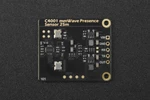








mmWave - C4001 24GHz Human Presence Detection Sensor (25 Meters, UART)
- $13.60 3+ items
- $13.30 5+ items
- $12.90 10+ items
Introduction
The C4001 millimeter-wave presence sensor utilizes a wavelength signal of 24GHz. It has a detection range of 100° horizontally, with a presence detection range of 16 meters and a motion detection and distance measurement range of 25 meters. It is suitable for human presence detection, environmental monitoring, and real-time monitoring projects.
Human detection
Compared to other types of presence sensors such as infrared sensors and ultrasonic sensors, the C4001(25m) millimeter-wave presence sensor has the advantage of being able to detect both static and moving objects. It also has a relatively strong anti-interference ability, making it less susceptible to factors such as temperature changes, variations in ambient light, and environmental noise. Whether a person is sitting, sleeping, or in motion, the sensor can quickly and sensitively detect their presence.

The differences between millimeter-wave presence sensor and infrared sensor
Distance and velocity detection
The C4001 (25m) millimeter-wave presence sensor utilizes Frequency Modulated Continuous Wave (FMCW) modulation for distance and speed measurement. It has a maximum measurement range of 25 meters for distance and a speed measurement range of 0.1 to 10 meters per second.
FMCW is a radar system based on Frequency Modulated Continuous Wave. Unlike traditional pulse radar, FMCW radar continuously emits a series of continuous wave signals with gradually changing frequencies while simultaneously receiving the reflected signals. By analyzing the received signals, measurements of parameters such as distance, velocity, and angle can be achieved.
Compared to traditional pulse radar technology, FMCW radar can continuously measure the distance of objects. By utilizing the Doppler effect, it can also obtain velocity information of the target objects. This makes it suitable for applications that require monitoring the motion status of target objects. Additionally, FMCW radar can achieve continuous frequency scanning, providing higher measurement resolution. Since it doesn't need to wait for the echo signal to return, it is suitable for applications that require real-time monitoring and tracking of target objects.

Detection Range of millimeter-wave human body sensor
What is a millimeter-wave radar sensor?
Millimeter-wave radar technology is a non-contact sensing technology used to detect objects and provide information about their distance, velocity, and angle (in the case of humans, for example). The signals emitted by millimeter-wave sensors fall within the high-frequency spectrum with wavelengths between 24GHz and 300 GHz, also known as the millimeter (mm) range.
Installation Method
The millimeter-wave human body sensor is sensitive to the installation method, and improper installation can affect the performance and functionality of the sensor. The commonly used installation methods for this module include top installation, bottom installation, horizontal installation, and downward tilted installation.

Top Installation Diagram of millimeter-wave human body sensor

Bottom Installation of millimeter-wave human body sensor

Horizontal Installation of millimeter-wave human body sensor

Wiring diagram of millimeter-wave human body sensor and Arduino Uno







